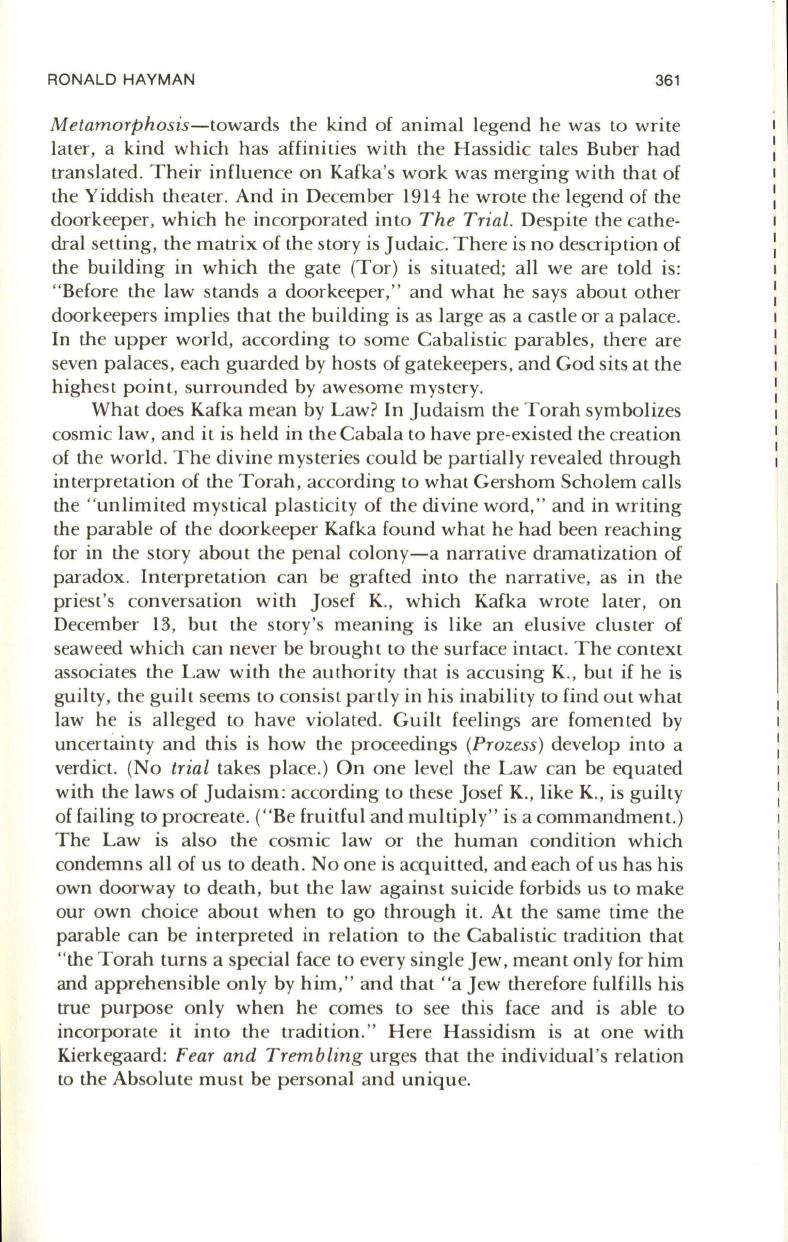
RONALD HAYMAN
361
Metamorphosis-towards
the kind of animal legend he was to write
later, a kind which has affinities with the Hassidic tales Buber had
translated. Their influence on Kafka's work was merging with that of
the Yiddish theater. And in December 1914 he wrote the legend of the
doorkeeper, which he incorporated into
The Trial.
Despite the cathe–
dral setting, the matrix of the story is Judaic. There is no description of
the building in which the gate (Tor) is situated; all we are told is:
"Before the law stands a doorkeeper," and what he says about other
doorkeepers implies that the building is as large as a castle or a palace.
In
the upper world, according to some Cabalistic parables, there are
seven palaces, each guarded by hosts of gatekeepers, and God sits at the
highest point, surrounded by awesome mystery.
What does Kafka mean by Law?
In
Judaism the Torah symbolizes
cosmic law, and it is held in the Cabala to have pre-existed the creation
of the world. The divine mysteries could be partially revealed through
interpretation of the Torah, according to what Gershom Scholem calls
the "unlimited mystical plasticity of the divine word," and in writing
the parable of the doorkeeper Kafka found what he had been reaching
for in the story about the penal colony-a narrative dramatization of
paradox. Interpretation can be grafted into the narrative, as in the
priest's conversation with Josef
K.,
which Kafka wrote later, on
December 13, but the story's meaning is like an elusive cluster of
seaweed which can never be brought to the surface intact. The context
associates the Law with the authority that is accusing K., but if he is
guilty, the guilt seems to consist partly in his inability to find out what
law he is alleged to have violated. Guilt feelings are fomented by
uncertainty and this is how the proceedings
(Prozess)
develop into a
verdict. (No
trial
takes place.) On one level the Law can be equated
with the laws of Judaism: according to these Josef
K.,
like
K.,
is guilty
of failing to procreate. ("Be fruitful and multiply" is a commandment.)
The Law is also the cosmic law or the human condition which
condemns all of us to death. No one is acquitted, and each of us has his
own doorway to death , but the law against suicide forbids us to make
our own choice about when to go through it. At the same time the
parable can be interpreted in relation to the Cabalistic tradition that
" the Torah turns a special face to every single Jew, meant only for him
and apprehensible only by him," and that "a Jew therefore fulfills his
true purpose only when he comes to see this face and is able to
incorporate it into the tradition." H ere Hassidism is at one with
Kierkegaard:
Fear and Trembling
urges that the individual 's relation
to the Absolute must be personal and unique.


